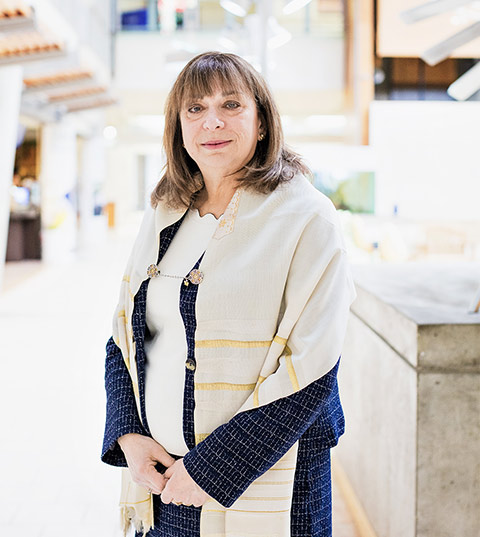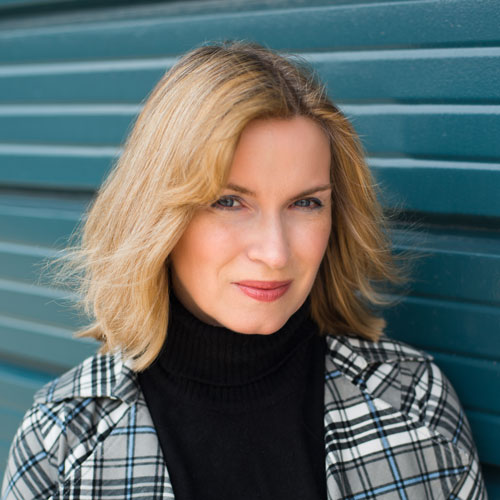Rena Arshinoff was sitting in a hospital cafeteria one day, taking a break from her work as a medical researcher. The institution’s chaplain, a Baptist minister she knew, approached her table and asked: “What are you reading?”
Arshinoff (MHSc 1983) obliged her with the title: A Woman’s Journey to God.
The chaplain’s response was unusual. She didn’t see this book as idle reading for Arshinoff, but as a step toward something bigger. “You’re going to be a rabbi,” she said.
Arshinoff was intrigued – especially since others, too, were suggesting that she look into this radically different career. Recently, she’d been leading services at her local synagogue and immersing herself in religious life. But at almost 50, the nurse-turned-epidemiologist could already look back on not one but two full careers. Could she really embark on a third?
“Never in a million years did I think I would become a rabbi,” she says now, sitting in her office at Toronto’s Baycrest Health Sciences, a seniors’ hospital, residence and research centre where she herself is now chaplain. “I was accustomed to science, and looking for statistical significance in the data. To me, if there wasn’t proof, how do we know?”
But the late 1990s had been a challenging time for Arshinoff; her sister Arlene (known as Cookie) died in 1997, followed by her father three years later. The empirical proof she regularly hunted down at work could offer certainty, but not comfort.
Arshinoff’s journey took shape as she stopped at her synagogue every day on her way to work to commemorate her father’s life. Jewish mourning is long and methodical, parcelled out into periods of time: seven days of intense grieving during shiva, then 30 days of shloshim, followed by – in the case of a deceased parent – a year in which the Kaddish, or Hebrew mourner’s prayer, is recited daily. With each passing day, as she did the prayers, the Hebrew language became more familiar to her. She began to wear a kippah (skullcap) and prayer shawl, and decided to have a bat mitzvah, something that had not been readily available to girls in 1960s Montreal.
After the year of formal mourning was over, “I thought I’d just go back to being Rena the Epidemiologist,” she says. “But that didn’t work.” Her newfound religious life was becoming more and more meaningful.
Arshinoff’s losses, while painful, had revealed to her the power of spirituality. “There is a profound sense of community in Judaism,” she says. “We do a lot of public mourning in community, and that involves supporting each other.”
After she began leading services, the comments began. You would be such a great rabbi, said one friend. Then another. And another. One friend told her three times. “You know,” Arshinoff responded, “one day I’m not going to laugh at that joke anymore.” Her friend said she wasn’t joking.
And so it was that Arshinoff embarked on the long, arduous path toward ordination. This involved five years of study in Israel and Cincinnati, psychological testing, and a lengthy period living apart from her husband and three children (two of whom had already left home themselves). She trained for a further year as a chaplain, and was ordained as a rabbi in 2008.
Today Arshinoff has returned to hospital life – but in a spiritual, instead of scientific, capacity. “Because I had a health-care background, it made sense,” she says. Her experience of mourning inspired her to specialize in grief counselling. She is currently completing a PhD in palliative care at Lancaster University in England, and works as an instructor in U of T’s bereavement education program, a joint venture between OISE and the Canadian Centre for Bereavement Education and Grief Counselling.
Undoubtedly, this is emotionally difficult work, but Arshinoff never doubts her chosen path. “It’s not easy to bear witness to another person’s suffering,” she says. “But I am so privileged to work with people as they experience the healing. To be able to offer them opportunities that help them work through their grief is just so rewarding.”
“One woman,” she says, “came to see me for two-and-a-half years after her mother died. She thought she’d never have a time where she wasn’t in pain every moment.” At length, however, “when she thought of her mother, she didn’t have the pain she used to have. She now feels joy, warmth, love and gratitude for the relationship she had.” Judaism, Arshinoff explains, recommends that grieving not be extended indefinitely; the timelines for prayers build structure into the process and provide guidance through ritual. Seeing grief as a job – terms such as “grief work,” or “tasks of mourning” are common in the field – is thought to be therapeutic, both inside and outside the faith.
“And at the same time, grief isn’t linear,” Arshinoff admits. “We can find ourselves on an emotional roller-coaster and sometimes it doesn’t take much to start grieving again. It could be a song on the radio, or something else.” Her own “something else” moment came in a grocery store when she was shopping for grapes, and caught the scent of her sister’s Clinique perfume on another shopper.
Such moments can be terribly sad, but they help Arshinoff identify with the people she counsels. These include children – she leads support groups as a volunteer with Bereaved Families of Ontario – as well as the seniors at Baycrest. In the past year, she has also started working with patients with spinal cord injuries at Toronto’s Lyndhurst Centre. “These patients are dealing with huge changes in their lives; they’re learning how to live a new kind of life,” she says. “Sometimes I’ll sit with family members, and ask how they’re managing.”
If it all seems a long way from the number-crunching and data analysis of her previous life, in some ways it isn’t. In the early years of Arshinoff’s epidemiology career, she worked as an AIDS researcher, neutralizing tragedy as best she could using reason and science. The book she was reading that day in the cafeteria – A Woman’s Journey to God – was actually written by a microbiologist who, says Arshinoff, “was tired of knowing people by their cells in petri dishes. She wanted to know who they really were.”
Last August, Arshinoff was appointed as an adjunct lecturer at U of T in the department of family and community medicine’s palliative care division. She hopes to teach students about health care’s qualitative aspects, rather than the quantitative metrics that dominated her past. “In my work now, I don’t look at statistics or p-values, I look at feelings. And feelings are not easily measured, or rational. Coming from science, I always thought I was a rational person. But I started to see that some components of life are more nebulous: They just require reflection – and acceptance.”
Recent Posts
For Greener Buildings, We Need to Rethink How We Construct Them
To meet its pledge to be carbon neutral by 2050, Canada needs to cut emissions from the construction industry. Architecture prof Kelly Doran has ideas
U of T’s 197th Birthday Quiz
Test your knowledge of all things U of T in honour of the university’s 197th anniversary on March 15!
Are Cold Plunges Good for You?
Research suggests they are, in three ways






One Response to “ A New Life After Loss ”
Love this story! It's so inspirational, and it made me think of my daughter. She has finished one degree and is now working through her second. Like so many young adults, she needs to know that she can explore more than one career path and not be afraid to do so. It just takes time and the passion to continue to learn and grow.